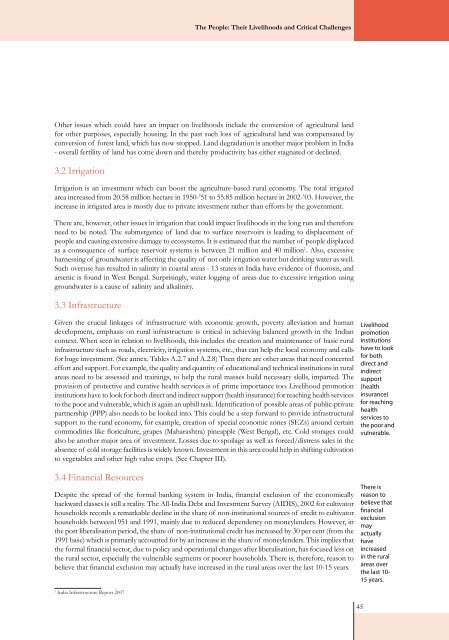SOIL Report 2008 - ACCESS Development Services
SOIL Report 2008 - ACCESS Development Services
SOIL Report 2008 - ACCESS Development Services
Create successful ePaper yourself
Turn your PDF publications into a flip-book with our unique Google optimized e-Paper software.
The People: Their Livelihoods and Critical ChallengesOther issues which could have an impact on livelihoods include the conversion of agricultural landfor other purposes, especially housing. In the past such loss of agricultural land was compensated byconversion of forest land, which has now stopped. Land degradation is another major problem in India- overall fertility of land has come down and thereby productivity has either stagnated or declined.3.2 IrrigationIrrigation is an investment which can boost the agriculture-based rural economy. The total irrigatedarea increased from 20.58 million hectare in 1950-’51 to 55.85 million hectare in 2002-’03. However, theincrease in irrigated area is mostly due to private investment rather than efforts by the government.There are, however, other issues in irrigation that could impact livelihoods in the long run and thereforeneed to be noted. The submergence of land due to surface reservoirs is leading to displacement ofpeople and causing extensive damage to ecosystems. It is estimated that the number of people displacedas a consequence of surface reservoir systems is between 21 million and 40 million 1 . Also, excessiveharnessing of groundwater is affecting the quality of not only irrigation water but drinking water as well.Such overuse has resulted in salinity in coastal areas - 13 states in India have evidence of fluorosis, andarsenic is found in West Bengal. Surprisingly, water logging of areas due to excessive irrigation usinggroundwater is a cause of salinity and alkalinity.3.3 InfrastructureGiven the crucial linkages of infrastructure with economic growth, poverty alleviation and humandevelopment, emphasis on rural infrastructure is critical in achieving balanced growth in the Indiancontext. When seen in relation to livelihoods, this includes the creation and maintenance of basic ruralinfrastructure such as roads, electricity, irrigation systems, etc., that can help the local economy and callsfor huge investment. (See annex. Tables A.2.7 and A.2.8) Then there are other areas that need concertedeffort and support. For example, the quality and quantity of educational and technical institutions in ruralareas need to be assessed and trainings, to help the rural masses build necessary skills, imparted. Theprovision of protective and curative health services is of prime importance too. Livelihood promotioninstitutions have to look for both direct and indirect support (health insurance) for reaching health servicesto the poor and vulnerable, which is again an uphill task. Identification of possible areas of public-privatepartnership (PPP) also needs to be looked into. This could be a step forward to provide infrastructuralsupport to the rural economy, for example, creation of special economic zones (SEZs) around certaincommodities like floriculture, grapes (Maharashtra) pineapple (West Bengal), etc. Cold storages couldalso be another major area of investment. Losses due to spoilage as well as forced/distress sales in theabsence of cold storage facilities is widely known. Investment in this area could help in shifting cultivationto vegetables and other high value crops. (See Chapter III).3.4 Financial ResourcesDespite the spread of the formal banking system in India, financial exclusion of the economicallybackward classes is still a reality. The All-India Debt and Investment Survey (AIDIS), 2002 for cultivatorhouseholds records a remarkable decline in the share of non-institutional sources of credit to cultivatorhouseholds between1951 and 1991, mainly due to reduced dependency on moneylenders. However, inthe post liberalisation period, the share of non-institutional credit has increased by 30 per cent (from the1991 base) which is primarily accounted for by an increase in the share of moneylenders. This implies thatthe formal financial sector, due to policy and operational changes after liberalisation, has focused less onthe rural sector, especially the vulnerable segments or poorer households. There is, therefore, reason tobelieve that financial exclusion may actually have increased in the rural areas over the last 10-15 years.Livelihoodpromotioninstitutionshave to lookfor bothdirect andindirectsupport(healthinsurance)for reachinghealthservices tothe poor andvulnerable.There isreason tobelieve thatfinancialexclusionmayactuallyhaveincreasedin the ruralareas overthe last 10-15 years.1India Infrastructure <strong>Report</strong> 200745














